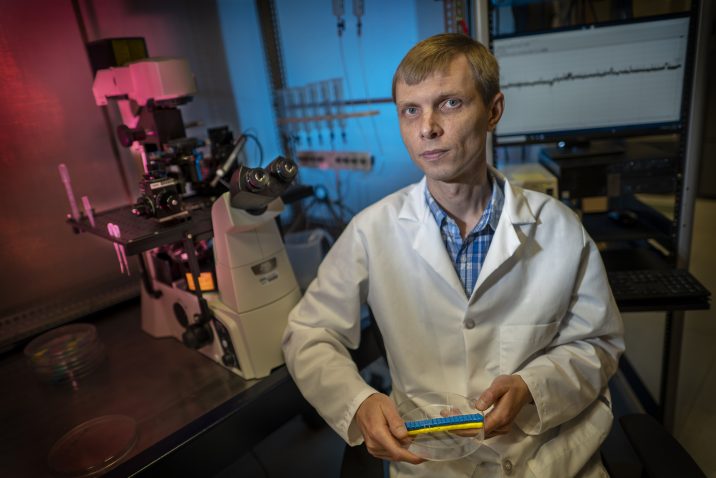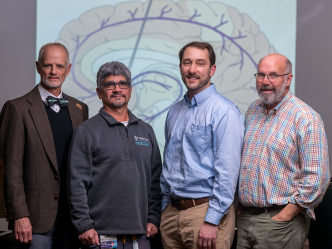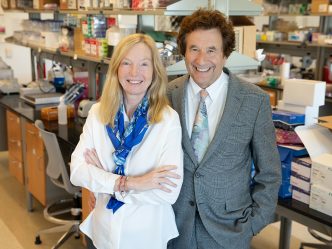Another difference between females and males appears to be a key mechanism in how they become hypertensive, scientists say, and consequently which antihypertensives should be most effective for them.
“There is cumulative evidence that while the fundamental system for blood pressure control is the same, blood pressure regulation in males and females is somewhat different,” says Dr. Mykola Mamenko, physiologist in the Department of Physiology at the Medical College of Georgia at Augusta University.
Mamenko’s lab has evidence in two common rat models of human hypertension, that in females, it is aldosterone, a hormone which cues our kidneys to hold onto more sodium and consequently more fluid, which drives blood pressure further up.
In their male hypertensive counterparts, it appears that the powerful blood vessel constrictor angiotensin II, another hormone that regulates the volume of circulating blood, is the primary messenger molecule telling the kidneys to keep retaining.
“In a hypertensive state, females rely on aldosterone significantly more than males,” says Mamenko, using the analogy of using your right or left hand to open the same door. In its aberrant state, the door stays open and more salt and fluid stay in the body, setting the stage for major killers like heart disease and stroke.
Mamenko recently received a $1.9 million grant (1R01DK125464-01A1) from the National Institute of Diabetes and Digestive and Kidney Diseases to learn more about these sex-differences he’s finding in the kidney’s key role in regulating blood pressure.
If his theories hold, the work should provide a mechanistic, preclinical explanation of why drugs that inhibit aldosterone receptors would work well in some females and likely are a good first treatment choice for them.
In fact, the main idea of his project and others further exploring the myriad of specific causes of high blood pressure, is to enable physicians to one day look in their patients’ blood for biomarkers of precisely which blood pressure type they have so they can choose the best fit from the plethora of antihypertensive drugs currently out there — 11 classes including diuretics, which is how the oldest aldosterone inhibitor, spironolactone, is classified, according to the American Heart Association.
“The causes are multiple,” Mamenko says. “What we are trying to do is identify more specific groups to which more targeted treatments can be applied and, in this case, we are aiming for sex,” a factor which is neither well studied nor understood in hypertension, he notes.
Our body uses the kidneys like “check valves,” to excrete more sodium and fluid when blood pressure gets high and to hold onto them when it gets dangerously low. Both angiotensin and aldosterone deliver the message to hold on to the epithelial sodium channel, or ENaC, in the tubules of the kidney, which enable the reuptake of sodium and which Mamenko calls a gateway for salt reabsorption. Tubules are long structures right off the approximately 1.5 million filtering units of the kidney, where resorption of things like water, glucose and amino acids also happen, and which pass waste along to the bladder for elimination. In the case of high blood pressure, salt or sodium, is a key ingredient that should be eliminated.
Mamenko’s lab has shown that blocking aldosterone receptors, called mineralocorticoid receptors, in hypertensive female rats decreases the overzealous, unhealthy activity of ENaC and results in more significant blood pressure decreases than in their male counterparts, “strongly suggesting” that aldosterone is an unrecognized, female-specific mechanism in chronic blood pressure regulation, he says. A bottom line appears to be that females are more sensitive to aldosterone.
“We have an idea of how it happens, now we want to answer why it happens,” Mamenko says.
He’s shown that female hypertensive rats have more receptors in their kidneys for the powerful hormone aldosterone, which seems like one logical explanation behind the sex differences he is finding.
One of the many things he’s now exploring is whether female rats with normal pressures, also have more aldosterone receptors.
He’s also treating male hypertensive rats with drugs that block production of angiotensin, and the females with aldosterone inhibitors — and vice versa — to see if theories like the females being more aldosterone sensitive hold.
One more twist is that normally when aldosterone levels get too high, “aldosterone escape” occurs within just a few weeks so you become less sensitive to the hormone and blood pressure can drop. It’s a sort of fail-safe mechanism to prevent endless resorption of salt and of the fluid that comes with it, Mamenko says. So they are looking at whether this natural protection is lost in females who are hypertensive while males continue to be protected, at least from excessive aldosterone.
He notes that aldosterone sensitivity is not always a bad thing. During pregnancy, for example, females rely heavily on aldosterone to retain the increased amount of sodium needed to provide the additional fluid volume needed to do things like produce sufficient amniotic fluid and increased blood volume for mother and developing baby. High levels of the female sex hormone progesterone, which is key to preparing the body for pregnancy, actually enables production of more aldosterone. In fact, high aldosterone levels routinely are associated with high progesterone levels.
Mamenko suspects this usual productive association gets “twisted” in hypertension, and aldosterone’s usual power to prompt retention of sodium in pregnant females can turn on females when blood pressure control “breaks.”
Another one of the many questions he wants to answer is whether in hypertension progesterone is augmenting the female response to aldosterone he is seeing, including whether it is increasing the number of those aldosterone receptors. He thinks the simple answer is ‘yes’ although how may vary.
One more strange twist is that, at least in the kidneys of males, progesterone effectively counteracts the action of aldosterone: males given progesterone urinate more frequently. But there is also evidence that in females, progesterone can be “cleaved” or divided in different ways to reduce its blocking effects on aldosterone action and some resulting products that even work with aldosterone.
For their studies, Mamenko’s lab used two models of hypertension which mimic types found in humans, including one where higher levels of angiotensin II drive blood pressure increases, but do so by increasing secretion of aldosterone, and another well-used model of salt-sensitive hypertension.
The physiologist views hypertension as a symptom, like a fever, that something is wrong with a variety of potential causes and no single solution. That’s why he wants to help identify cohorts of people with the same causes, which may include gender-related ones, or disease-related ones like having high aldosterone levels from an adrenal tumor, or diabetes, which damages and stiffens blood vessel walls.
He notes that kidneys are a key place to identify trouble because you could, in theory and likely reality, pee out endless amounts of excess salt and water, while other ways to lower blood pressure, like reducing the heart rate or dilating blood vessels, have clear limits.
He also thinks the kidneys are likely the first place, or at least an early place, for “breaks” in the usual signaling to happen since high blood pressure requires higher fluid volume which requires the kidneys. However the system can also can be broken in the blood vessels and our brains.
Hypertension is a leading, modifiable risk factor for cardiovascular and kidney disease, Mamenko says. About half of the adults in the United States are considered hypertensive, according to the Centers for Disease Control and Prevention, with an estimated one in four having their blood pressure well controlled and males having slightly higher rates of high blood pressure, the CDC says.
Treatment choices that don’t directly address the cause of hypertension in an individual along with treatment noncompliance account for the high rate of uncontrolled pressures, experts say.
 Augusta University
Augusta University




